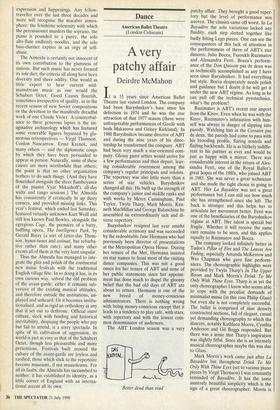Dance
A very patchy affair
Deirdre McMahon
It is 13 years since American Ballet Theatre last visited London. The company had been Baryshnikov's base since his defection in 1974 and he was the star attraction of that 1977 season (there were unforgettable performances of Giselle with both Makarova and Gelsey Kirkland). In 1980 Baryshnikov became director of ABT and during the nine years of his direc- torship he transformed the company. ABT had been very much a star-oriented com- pany. Glossy guest artists would arrive for a few performances and then depart, leav- ing considerable resentment among the company's regular principals and soloists. The repertory was also little more than a series of star vehicles. Baryshnikov changed all this. He built up the strength of the company's junior and middle ranks and with works by Merce Cunningham, Paul Taylor, Twyla Tharp, Mark Morris, Ken- neth MacMillan and George Balanchine he assembled an extraordinarily rich and di- verse repertory.
Baryshnikov resigned last year amidst considerable acrimony and was succeeded by the redoubtable Jane Hermann who had previously been director of presentations at the Metropolitan Opera House. During her tenure of the Met, Hermann insisted on star names to front most of the visiting dance companies. This was not a good omen for her tenure of ABT and none of her public statements since her appoint-
ment has done much 'to dispel the gloomy belief that the bad old days of ABT are about to return. Hermann is one of the
new breed of money-conscious administrators. There is nothing wrong with being money-conscious except that it leads to a tendency to play safe, with stars, with repertory and with the lowest com- mon denominator of audiences.
The ABT London season was a very 'Better dead than read' patchy affair. They brought a good reper- tory but the level of performance was uneven. The classics came off worst. In La Bayadere the solo variations lacked any fluidity, each step slotted together like badly fitting Lego pieces. One can see the consequences of this lack of attention in the performances of three of ABT's star dancers: Julio Bocca, Faroukh Ruzimatov and Alessandra Ferri. Bocca's perform- ance of the Don Quixote pas de deux was as technically accomplished as any I have seen since Baryshnikov. It had everything but style. Bocca desperately needs polish and guidance but I doubt if he will get it under the new ABT regime. As long as he can pull off the technical pyrotechnics, what's the problem?
Ruzimatov is ABT's recent star import from the Kirov. Even when he was with the Kirov, Ruzimatov's infatuation with him- self was always in danger of slipping into parody. Watching him in the Corsaire pas de deux, the parody had come to pass with his brooding profile, flaring nostrils and flailing backbends. He is as blithely indiffe- rent to his partner as ever and would be just as happy with a mirror. There was considerable interest in the return of Ales- sandra Ferri, one of the Royal Ballet's great hopes of the 1980s, who joined ABT in 1985. She was never a great technician and she made the right choice in going to ABT. Her La Bayadere was not a great performance but I can still see how much she has strengthened since she left. The back is stronger and this helps her to articulate her movement better. Ferri was one of the beneficiaries of the Baryshnikov regime at ABT. Her talent is special but fragile. Whether it will receive the same care remains to be seen, and this applies equally to Ruzimatov and Bocca.
The company looked infinitely better in Tudor's Pillar of Fire and The Leaves Are Fading, especially Amanda McKerrow and Wes Chapman who gave fine perform- ances. The choreographic highlights were provided by Twyla Tharp's In The Upper Room and Mark Morris's Drink To Me Only With Thine Eyes. Tharp is as yet the only choreographer I know who seems able to cope with the peculiar demands of minimalist music (in this case Philip Glass) but even she is not completely successful. The ballet is comprised of nine densely constructed sections, full of elegant, casual yet demanding choreography to which the dancers, notably Kathleen Moore, Cynthia Anderson and Gil Boggs responded. But there was a sense that Tharp's inspiration was slightly fitful. Since she is an intensely musical choreographer maybe this was due to Glass.
Mark Morris's work came just after La Bayadere but throughout Drink To Me Only With Thine Eyes (set to various piano pieces by Virgil Thomson) I was constantly reminded of Bayadere. It has the same austerely beautiful simplicity which is the sign of a great choreographer. Morris is also intensely musical. At the heart of the work are two male and female trios full of speedy, brilliant phrases which challenged and extended the dancers. This was a marvellous piece.



















































 Previous page
Previous page